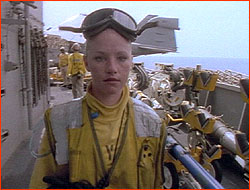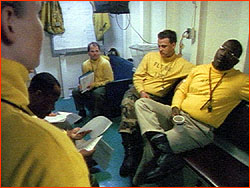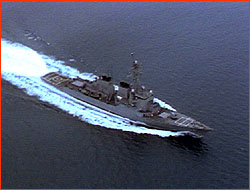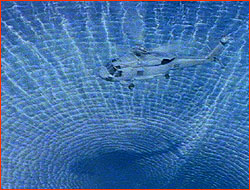 |
 |
 |
Part 2 | back to Part 1 James, Another day on the John C. Stennis has come to a close; a good one. Got a lot done. Viewed from eight decks above the flight deck, in and around the planes, bombs, and moving machinery, the carrier looks as though someone had opened a box of Crayolas and spilled them out. These "crayons" are in fact a mass of people adorned in various colors, each color representing their specific job. White shirts are "safety," blue shirts are "chock and chains," red are "weapons," green "avionics," purple "fuel," and yellow shirts are the "airplane handlers." Now, these yellow shirts folks are the people who run the deck; even the pilots don't fly until the yellow shirt hooks them up to the Cat and sends them on their way. They direct the aircraft around the deck, tell them where to park and when. Twelve years ago when I was on the Kennedy I followed a yellow shirt around; he was a burly guy, very macho in a world where testosterone equated to your ability to "move aircraft." Onto the 1998 flight deck comes the new face of plane "handlers." Her name is Jennifer. She is great. She joined the Navy to basically get a life. We pick her up (in movie terms only) on the deck of the carrier moving 30-ton aircraft whilst slinging yards of chain around her shoulders, barking orders above the general din; she's found her place.
The heat of summer is finally starting to hit us here. The first week was quite a surprise, with temperatures at night getting down enough that you'd need a long-sleeved shirt. That honeymoon is over. Even before the planes start to wind up on deck, the mandatory long sleeves are too much. Once 20 or 25 jets start firing and turning in this small space the overall temperature across the deck feels like about 115 degrees Fahrenheit. Whole lot of fun. We're here for another three or four days, then onto the Indy and after that the Tucson and the "bubbleheads." Kirk
In this case, the Gulf, we are in the midst of a "battle force," that is two battle groups combined. In addition to two aircraft carriers, each has a complement of "small boys," i.e., battle cruisers with Aegis systems, destroyers with "lamps," equipped helicopters, a couple of submarines out there with an arsenal of Tomahawk vertical launch missiles and, of course, the Marines. Just in case we need to go ashore, there are a couple of amphibious units of Marines just itching to get off the boat and fight with someone other than each other.
Admiral Moore, in charge of the battle force, made a very good point; he's much less worried about the "big attack" than the isolated incident (a terrorist bombing, etc.) that makes this huge armada look like a dinosaur. It's an event they pay a lot of attention to. Regarding the "big attack," picking a fight with these guys is the military equivalent of a house call from Dr. Kevorkian. Continue Breakdown of a Battle Group | Women on the Carrier | Behind the Scenes Resources | Transcript | Site Map | Battle Alert Home Editor's Picks | Previous Sites | Join Us/E-mail | TV/Web Schedule About NOVA | Teachers | Site Map | Shop | Jobs | Search | To print PBS Online | NOVA Online | WGBH © | Updated October 2000 |
 Jennifer Keefer,
training to become a yellow shirt.
Jennifer Keefer,
training to become a yellow shirt.
 Jennifer Keefer takes her test to become a yellow shirt.
Jennifer Keefer takes her test to become a yellow shirt.
 A destroyer
is just one of the "small boys" of a battle group.
A destroyer
is just one of the "small boys" of a battle group.
 A helicopter helps search for
stealthy submarines.
A helicopter helps search for
stealthy submarines.